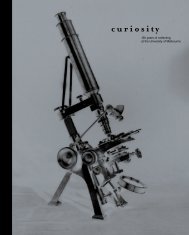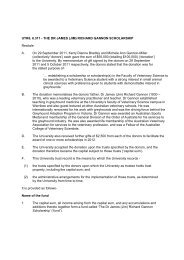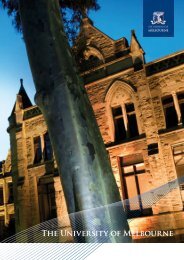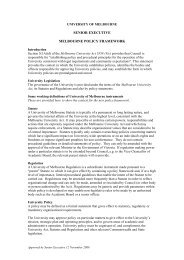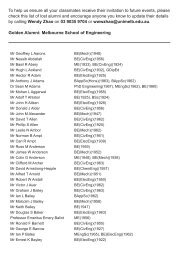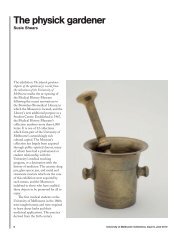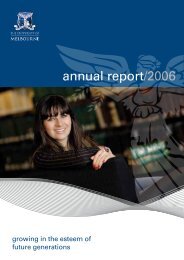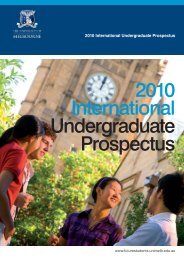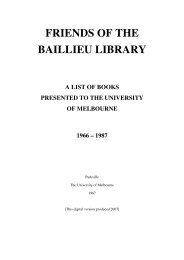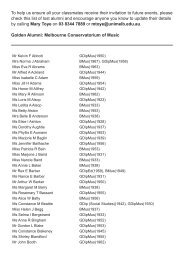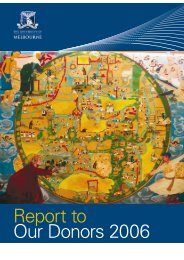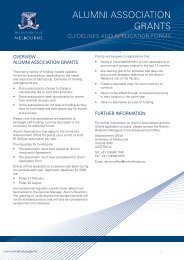2007 Annual report (PDF 8.1 Mb) - University of Melbourne
2007 Annual report (PDF 8.1 Mb) - University of Melbourne
2007 Annual report (PDF 8.1 Mb) - University of Melbourne
Create successful ePaper yourself
Turn your PDF publications into a flip-book with our unique Google optimized e-Paper software.
INTRODUCTION<br />
And OVERVIEW<br />
In <strong>2007</strong> <strong>Melbourne</strong> maintained its position<br />
as a leading national research university,<br />
scoring strongly against every national<br />
research indicator and recording its best<br />
ever performance in competitive grant<br />
income. Performance in ARC Discovery<br />
and NHMRC project grants was particularly<br />
strong and well up on 2006 figures.<br />
<strong>Melbourne</strong> remains one <strong>of</strong> Australia’s<br />
largest universities in terms <strong>of</strong> both<br />
research income and expenditure.<br />
Global Links<br />
The progress <strong>of</strong> knowledge relies on<br />
international effort. The <strong>University</strong><br />
participates in global opportunities<br />
and the sharing <strong>of</strong> knowledge in many<br />
ways – through international networks,<br />
international partnerships and some 180<br />
bilateral agreements with universities<br />
around the world. <strong>Melbourne</strong> has been<br />
a keen participant in the activities <strong>of</strong> the<br />
Association <strong>of</strong> Pacific Rim Universities<br />
(APRU) in its first year <strong>of</strong> membership,<br />
while continuing to engage in collaborative<br />
and entrepreneurial activities through the<br />
Universitas 21 network. The <strong>University</strong><br />
consolidated its strategic presence in<br />
the Asia – Pacific region through new<br />
international <strong>of</strong>fices in Kuala Lumpur,<br />
Singapore and Bangalore, complementing<br />
existing <strong>of</strong>fices in Jakarta and Bangkok. In<br />
July we formed a partnership with seven<br />
Malaysian universities for a PhD program<br />
designed to build capacity in the Malaysian<br />
higher education sector, allowing candidates<br />
to split their research time between<br />
<strong>Melbourne</strong> and their Malaysian university.<br />
Pushing against the national trend <strong>of</strong><br />
declining international student enrolments,<br />
the <strong>University</strong> was once again successful in<br />
attracting a large number <strong>of</strong> well-qualified<br />
students from overseas to its programs.<br />
Of the 44,500 students enrolled at the<br />
<strong>University</strong> in <strong>2007</strong>, over 11,000 (27 per<br />
cent <strong>of</strong> the teaching load) are international<br />
students from more than 115 countries.<br />
Outstanding<br />
Undergraduate Intake<br />
<strong>Melbourne</strong> again experienced high<br />
demand for its undergraduate places from<br />
outstanding domestic students in <strong>2007</strong>,<br />
resulting in a median ENTER score for<br />
Victorian school leavers <strong>of</strong> 94.7, 5.2 points<br />
higher than the closest Victorian university.<br />
<strong>Melbourne</strong> again recorded a substantial<br />
number <strong>of</strong> domestic undergraduate feepaying<br />
students, all <strong>of</strong> whom received<br />
high ENTER scores and were eligible for<br />
a government-subsidised place in other<br />
courses or at other institutions.<br />
Funding<br />
While governments continue to be<br />
important contributors, in <strong>2007</strong> funding<br />
from Commonwealth and Victorian<br />
governments, excluding research funding,<br />
constituted just 25.8 per cent <strong>of</strong> total<br />
revenue. Commonwealth funding from all<br />
sources (including research) other than the<br />
Higher Education Contribution Scheme<br />
has diminished from 56 per cent <strong>of</strong> the<br />
total in 1996 to 41.0 per cent in <strong>2007</strong>. The<br />
<strong>University</strong>’s consolidated income <strong>of</strong> $1.43<br />
billion in <strong>2007</strong> was up by 11.7 per cent on<br />
2006, due largely to continuing growth <strong>of</strong><br />
fee-revenue and research and investment<br />
income. Overall, <strong>Melbourne</strong> has been<br />
successful in achieving a 11.54 per cent<br />
increase in unit-<strong>of</strong>-resource student funding<br />
since 2004, i.e. $34,700 to $38,704. The<br />
<strong>University</strong>’s financial strength has been<br />
confirmed by continuation <strong>of</strong> its Standard<br />
and Poor’s credit-rating at AA+, the highest<br />
rating available to an Australian university.<br />
Outlook<br />
These are exciting times for the <strong>University</strong>.<br />
<strong>2007</strong> proved a year <strong>of</strong> important progress<br />
toward a new learning and teaching agenda<br />
for <strong>Melbourne</strong>, enhanced research focus,<br />
the widescale adoption <strong>of</strong> Knowledge<br />
Transfer, and a series <strong>of</strong> local actions to<br />
create a university which <strong>of</strong>fers great<br />
facilities to students from home and abroad.<br />
It is testament to the commitment and<br />
pr<strong>of</strong>essionalism <strong>of</strong> the <strong>University</strong>’s staff<br />
that implementation <strong>of</strong> Growing Esteem<br />
has not detracted from the <strong>University</strong>’s<br />
performance as a leading Australian<br />
<strong>University</strong> in <strong>2007</strong>. In 2008 we will continue<br />
to reshape an institution <strong>of</strong> great social,<br />
economic and cultural significance, paying<br />
particular attention to the values that guide<br />
our journey to becoming one <strong>of</strong> the finest<br />
universities in the world.<br />
Pr<strong>of</strong>essor Glyn Davis AC<br />
Vice-Chancellor<br />
PROFILE<br />
Pr<strong>of</strong>essor<br />
MARCUS Pandy<br />
Chair <strong>of</strong> Mechanical and Biomedical<br />
Engineering, Pr<strong>of</strong>essor Marcus<br />
Pandy, is leading a $4 million research<br />
project mapping the way we move<br />
and how this impacts on our joints.<br />
The research is aimed at better<br />
understanding the biomechanics and<br />
control <strong>of</strong> human movement.<br />
The Human Movement research project<br />
has been established within NICTA,<br />
Australia’s research centre <strong>of</strong> excellence<br />
in Information and Communication<br />
Technology. Pr<strong>of</strong>essor Pandy is using<br />
sophisticated fluoroscopy X-rays and<br />
computer generated modelling, to track<br />
a range <strong>of</strong> indicators including muscle<br />
use, rotation and force to map how<br />
humans move.<br />
The focus is on applying engineering<br />
techniques to address a range <strong>of</strong><br />
clinical problems, such as movement<br />
abnormalities caused by knee-ligament<br />
injury, knee joint osteoarthritis, and<br />
cerebral palsy. Pr<strong>of</strong>essor Pandy uses<br />
mathematical models to simulate a<br />
range <strong>of</strong> movements. Analysis <strong>of</strong> the<br />
models helps understanding <strong>of</strong> which<br />
muscles move particular joints and<br />
how muscles contribute to the stress<br />
patterns developed at each joint.<br />
The models have far reaching<br />
assessment and diagnostic<br />
possibilities. Pr<strong>of</strong>essor Pandy has<br />
received national and international<br />
awards for his research on<br />
computational modelling <strong>of</strong> movement.<br />
He is a Fellow <strong>of</strong> the American Society<br />
<strong>of</strong> Mechanical Engineers and a Fellow<br />
<strong>of</strong> the American Institute <strong>of</strong> Medicine<br />
and Biology in Engineering.<br />
The <strong>University</strong> <strong>of</strong> <strong>Melbourne</strong> <strong>Annual</strong> Report <strong>2007</strong> 11



